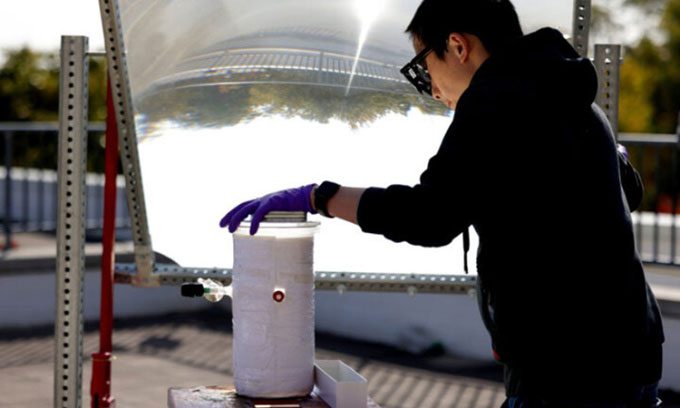Scientists Develop New Self-Healing Semiconductors for Solar Water Splitting Devices, Enhancing Hydrogen Production Efficiency.
A team of experts at the University of Michigan has developed a new solar energy device that achieves an efficiency of up to 9% in converting water into hydrogen through artificial photosynthesis. This represents a technological leap, nearly 10 times more effective than similar solar water-splitting experiments.

Peng Zhou using a large lens to focus sunlight on the water-splitting catalyst. (Photo: Brenda Ahearn/University of Michigan).
The greatest benefit of this new technology is the reduction in the cost of producing sustainable hydrogen. The research team achieved this by miniaturizing the semiconductor, which is typically the most expensive component of the device. Their self-healing semiconductor can withstand concentrated light equivalent to 160 suns. The new research was published in the journal Nature on January 4.
The scientists achieved outstanding results thanks to two advances:
The first is the ability to concentrate sunlight without damaging the semiconductor. “We have reduced the size of the semiconductor by more than 100 times compared to some types that only function at low light intensities. Hydrogen produced using our technology can be very cheap,” said Peng Zhou, a computer and electrical engineering researcher at the University of Michigan and a member of the research team.
The second advancement involves using both the higher energy portion of the solar spectrum to split water and the lower energy portion to provide heat to drive the reaction. This is made possible by the self-healing semiconductor catalyst, which does not degrade like many other catalysts during sunlight harvesting.
In addition to withstanding high light intensities, the new device also operates well even at high temperatures that typically damage semiconductors in computers. High temperatures accelerate the water-splitting process while maintaining the separation of hydrogen and oxygen, instead of forming new bonds and reverting to water. Both factors have contributed to the research team harvesting more hydrogen.
In outdoor tests, Zhou constructed a large lens from a window to focus sunlight onto a test panel that was only a few centimeters wide. On the panel, the semiconductor catalyst is covered by a layer of bubbling water as hydrogen and oxygen are separated.
A simple insulation layer above the panel maintains the temperature at 75 degrees Celsius, hot enough to drive the reaction and cool enough for the semiconductor catalyst to function effectively. The outdoor test device, under unstable light and temperature conditions, achieved a solar-to-hydrogen fuel conversion efficiency of 6.1%. Indoors, the device achieved efficiencies of up to 9%.
The research team intends to continue improving efficiency and obtaining ultra-pure hydrogen that can be directly used for fuel cells.



















































